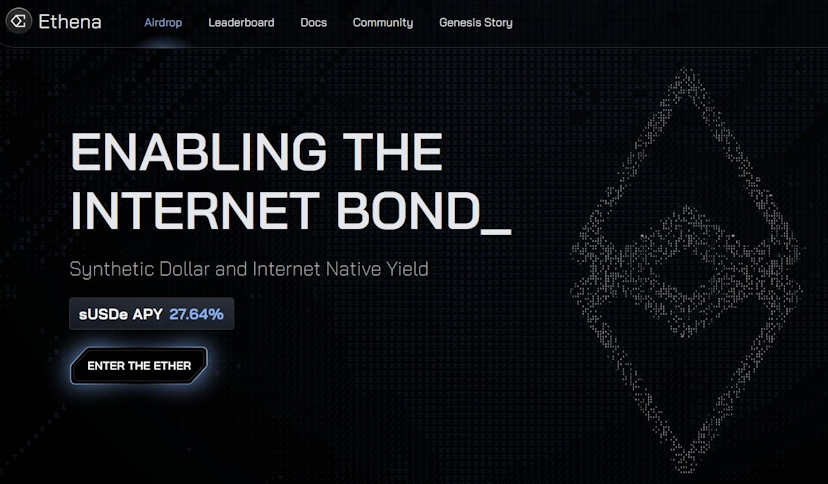Ethena Stablecoin’s 27% Yield is Triggering Terra-Induced PTSD
The startup’s token, USDe, is backed by staked ETH and ETH short positions.
By: Pedro Solimano • Loading...
DeFi
Synthetic stablecoin startup, Ethena Labs, is raising eyebrows after announcing it will offer over 20% yield on its USD-pegged token.
Ethena’s Labs’s USDe stablecoin offers a 27% yield, and is available for the public since Feb. 19, when the mainnet and Etherena’s “Shard Campaign'' went live.
According to the team, users have the choice between staking USDe and receiving yield generated by the protocol from stETH and funding rates from short ETH positions, or accumulating so-called “shards,” which track and reward a user depending on how much they contributed to the ecosystem. Sharda are obtained by providing liquidity to Curve.
The 20-plus yield on a stablecoin has triggered Crypto Twitter, as the pitch sounds similar to Terra’s UST algorithmic stablecoin, which lured investors with a 19% yield. In early May 2022, UST began to lose its peg, as LUNA, the token backing it, started to drop in value. The sharp drop in UST collateral prompted a death spiral which wiped out $50 billion in market capitalization over the course of three days. UST’s collapse seared into some crypto investors’ mind the old economic axiom, “there’s no free lunch.”
So when Ethena erupted on the crypto scene with a Dragonfly-led $14 million-dollar seed round and its 27% yield, many were quick to ask where the yield came from.
Where Does the Yield Come From?
The “synthetic dollar,” said the firm, is collateralized with crypto assets–such as staked Ethereum (stETH)–and corresponding short futures positions on centralized exchanges.
Ethena Labs is able to offer its high yield thanks to a blend of native staking returns, which sit at roughly 4%, and average funding paid to shorts, which currently sits at 23%.

Guy Young, founder of Ethena Labs, points out that USDe “combines the only two forms of scalable crypto native yield in a single instrument: i) stETH ~4%, mETH ~7% or LRTs TBD + ii) Short ETH perpetual ~13-26% last 3m.”
The firm has also built a dashboard that breaks down the average collateral yield for the portfolio.
What Are the Risks?
Austin Campbell, founder and managing partner of Zero Knowledge Consulting firm, said Ethena is a “truly interesting experiment” and is substituting credit risk with price risk.
Ethena’s USDe is exposed to Ethereum’s Ether price, as funding rates for ETH short positions can turn negative as easily as the market changes sentiment.
Funding rates for Ethereum have remained in line with the token’s price, both consistently trending positive over the past six months. Rates haven't been negative since mid. Sep. 2023, when ETH neared its local price bottom, dropping to $1,536 one month later.
Ethena has a $10 million insurance fund to counter potential negative funding rates.

Ethena is also exposed to the infrastructure they are using to receive Ethereum staking yield. Campbell said the protocol will encounter risks whether they operate their own validators, or if it is outsourcing validation as they will be taking on third party risk .
Is USDe Actually a Stablecoin?
Aside from questions surrounding yield, some industry experts say that while the protocol is a much-needed innovation, it uses the wrong nomenclature.
Ryan Watkins, co-founder of Syncracy Capital, said USDe should be conceptualized as a structured product, and not a stablecoin because of its unique blend of stETH yield returns and short funding rates.
Watkins claimed that not calling it a stablecoin, in fact, would allow for “much more intelligent discourse” surrounding the project.
Since it’s continually labeled a stablecoin, he wrote, “we’re left with a bunch of midwit comparisons to Terra on one end and lazy comparisons to DAI and other multi-collateral stablecoins on the other.”
But, according to Watkins, unlike Terra, Ethena is fully collateralized, with its yield originating from the aforementioned staked returns and funding rates. When compared to DAI, he reckons they are complimentary, with USDe supply and leveraged trades to boost, and DAI offering a “key source” for liquidity.
His view resonates with Nic Carter, co-founder of Castle Island Ventures, and long time advocate of stablecoins, as well as Eliezer Ndinga, VP and head of strategy for 21.co.
Ethena Labs unveiled a $14 million round on Feb. 16, led by venture capital firm, Dragonfly. The protocol currently has $345 million in total value locked.
Advertisement
Get the best of The Defiant directly in your inbox 💌
Know what matters in Web3 with The Defiant Daily newsletter, every weekday
90k+ investors informed every day. Unsubscribe anytime.